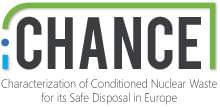WP5 – Innovative gas and outgassing analysis and monitoring
Objectives
This work package aims to advance the use of innovative techniques based on laser spectroscopy for gaseous radioactive emissions monitoring. One of the most sensitive spectroscopy technique, called cavity ring-down spectroscopy (CRDS), will be applied to the detection of radioisotopes, which are of interest in the context of characterisation of waste outgasing. The WP consists of two tasks where the detection of Cl-36 and radiocarbon using CRDS will be investigated.
Current methods used for detection of long-lived radioisotopes are mainly laboratory-based techniques, which cannot provide on-site monitoring capabilities. Optical techniques, such as laser spectroscopy, on the other hand, have inherent on-site monitoring capabilities, as it can provide compact, transportable, and reliable instrumentation, while still achieving very high sensitivity. Cavity ring-down spectroscopy is one of the most sensitive laser spectroscopic technique as it uses an absorption path length of several kilometres, thanks to the use of an optical cavity with high-reflectivity mirrors. Its principle is described in Figure 1. The technique is routinely used in environmental and emission monitoring but has never been applied to the characterisation of nuclear waste outgasing. The development of the technique for the detection of radioisotopes of interest will provide a sensitive and compact way of monitoring the waste outgasing, thus greatly benefiting various applications in the nuclear field. The WP therefore aims to advance the use of Cavity Ring-Down Spectroscopy as an innovative technique to characterize outgassing of radioactive waste by developing new instrumentation for H36Cl and demonstrating an application of the technique to the monitoring of radiocarbon outgassing.
Tasks
Task 5.1 is dedicated to the development of H36Cl measurement. The development of the H36Cl measurement technic with CRDS will first necessitate the validation of the rotation/vibration properties of the H36Cl molecule. This validation will be done by simulation and experimentally. A prototype of CRDS instrument dedicated to H36Cl measurement will be studied and constructed. The performances of the CRDS will then be evaluated with laboratory tests on 36Cl standards and graphite samples and compared with other techniques.
Task 5.2 aims to investigate the release behaviour of 14C in the form of carbon dioxide and methane using CRDS. Irradiated graphite in different storing conditions, as well as one other type of radioactive waste will be investigated. The technique will also be compared to liquid scintillation counting.
Deliverables
D5.1 Report on validation of transitions of rotation/vibration on HCl, specification and development of the equipment
D5.2 Report on experimental validation of the transitions with 36Cl standards and detection limit
D5.3 Report on laboratory tests of the equipment on graphite samples and comparison of CRDS performances with conventional technique
D5.4 Report on study of the release behaviour of radiocarbon from irradiated graphite waste using CRDS
D5.5 Report on validation of CRDS for radiocarbon detection performances with liquid scintillation counting techniques
D5.6 Report on study of the release behaviour of radiocarbon from another type of waste
Partners involved
Leader: VTT
Contributors: CEA, ENEA, FZJ
